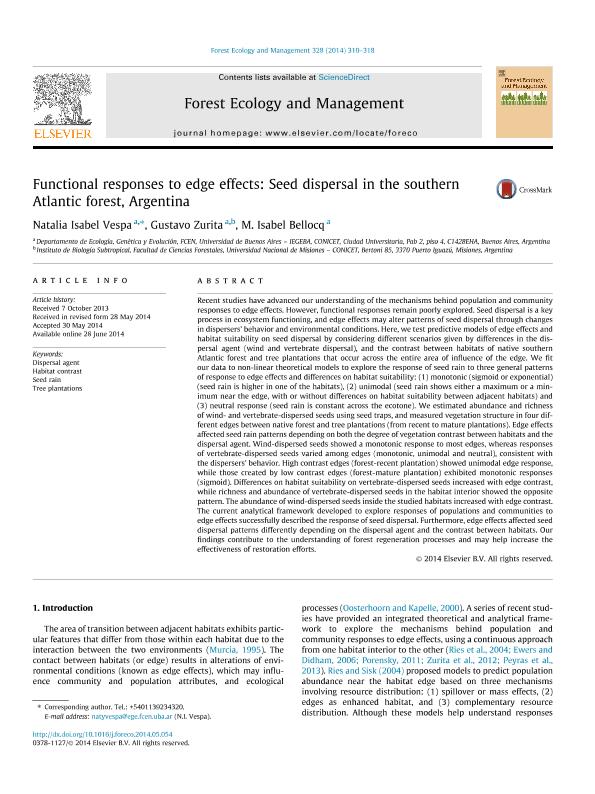Artículo
Functional responses to edge effects: Seed dispersal in the southern Atlantic forest, Argentina
Fecha de publicación:
09/2014
Editorial:
Elsevier Science
Revista:
Forest Ecology and Management
ISSN:
0378-1127
Idioma:
Inglés
Tipo de recurso:
Artículo publicado
Clasificación temática:
Resumen
Recent studies have advanced our understanding of the mechanisms behind population and community responses to edge effects. However, functional responses remain poorly explored. Seed dispersal is a key process in ecosystem functioning, and edge effects may alter patterns of seed dispersal through changes in dispersers' behavior and environmental conditions. Here, we test predictive models of edge effects and habitat suitability on seed dispersal by considering different scenarios given by differences in the dispersal agent (wind and vertebrate dispersal), and the contrast between habitats of native southern Atlantic forest and tree plantations that occur across the entire area of influence of the edge. We fit our data to non-linear theoretical models to explore the response of seed rain to three general patterns of response to edge effects and differences on habitat suitability: (1) monotonic (sigmoid or exponential) (seed rain is higher in one of the habitats), (2) unimodal (seed rain shows either a maximum or a minimum near the edge, with or without differences on habitat suitability between adjacent habitats) and (3) neutral response (seed rain is constant across the ecotone). We estimated abundance and richness of wind- and vertebrate-dispersed seeds using seed traps, and measured vegetation structure in four different edges between native forest and tree plantations (from recent to mature plantations). Edge effects affected seed rain patterns depending on both the degree of vegetation contrast between habitats and the dispersal agent. Wind-dispersed seeds showed a monotonic response to most edges, whereas responses of vertebrate-dispersed seeds varied among edges (monotonic, unimodal and neutral), consistent with the dispersers' behavior. High contrast edges (forest-recent plantation) showed unimodal edge response, while those created by low contrast edges (forest-mature plantation) exhibited monotonic responses (sigmoid). Differences on habitat suitability on vertebrate-dispersed seeds increased with edge contrast, while richness and abundance of vertebrate-dispersed seeds in the habitat interior showed the opposite pattern. The abundance of wind-dispersed seeds inside the studied habitats increased with edge contrast. The current analytical framework developed to explore responses of populations and communities to edge effects successfully described the response of seed dispersal. Furthermore, edge effects affected seed dispersal patterns differently depending on the dispersal agent and the contrast between habitats. Our findings contribute to the understanding of forest regeneration processes and may help increase the effectiveness of restoration efforts.
Palabras clave:
Dispersal Agent
,
Habitat Contrast
,
Seed Rain
,
Tree Plantations
Archivos asociados
Licencia
Identificadores
Colecciones
Articulos(IBS)
Articulos de INSTITUTO DE BIOLOGIA SUBTROPICAL
Articulos de INSTITUTO DE BIOLOGIA SUBTROPICAL
Citación
Vespa, Natalia Isabel; Zurita, Gustavo Andres; Bellocq, Maria Isabel; Functional responses to edge effects: Seed dispersal in the southern Atlantic forest, Argentina; Elsevier Science; Forest Ecology and Management; 328; 9-2014; 310-318
Compartir
Altmétricas




